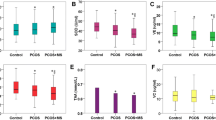Abstract
Objective
To determine the oxidative balance and plasma fatty acid composition of overweight and obese women.
Design
Comparative, descriptive study on 60 overweight or obese (BMI 25–33 kg/m2), normotensive, nondiabetic women and 60 age-matched lean healthy women (BMI < 25 kg/m2).
Measurements
Plasma lipid, hydroperoxide, and antioxidants levels, fatty acid composition and the susceptibility of lipoproteins to peroxidation.
Results
Compared to the lean control group, the patient group had higher susceptibility of lipoproteins to peroxidation and higher peroxide levels. In contrast, the polyunsaturated fatty acids, in particular the ω-3 species, and the antioxidants were lower in the patient group.
Conclusions
The present study shows that overweight and obese people have oxidative balance impairment. The higher susceptibility of lipoproteins to peroxidation is the probable molecular mechanism that promotes a reduction in high unsaturated (and in particular ω-3) fatty acids, as well as antioxidants in the plasma of the overweight and obese subjects.
Similar content being viewed by others
References
Saito I, Yonemasu K, Inami F (2003) Association of body mass index, body fat, and weight gain with inflammation markers among rural residents in Japan. Circ J 67:323–329
Kopp HP, Kopp CW, Festa A, Krzyzanowska K, Kriwanek S, Minar E et al (2003) Impact of weight loss on inflammatory proteins and their association with the insulin resistance syndrome in morbidly obese patients. Arterioscler Thromb Vasc Biol 23:1042–1047
Weyer C, Yudkin JS, Stehouwer CD, Schalkwijk CG, Pratley RE, Tataranni PA (2002) Humoral markers of inflammation and endothelial dysfunction in relation to adiposity and in vivo insulin action in Pima Indians. Atherosclerosis 161:233–242
Lyon CJ, Law RE, Hsueh WA (2003) Minireview: adiposity, inflammation, and atherogenesis. Endocrinology 144:2195–2200
Berliner JA, Heinecke JW (1996) The role of oxidized lipoproteins in atherogenesis. Free Radic Biol Med 20:707–727
Prazny M, Skrha J, Hilgertova J (1999) Plasma malondialdehyde and obesity: is there a relationship? Clin Chem Lab Med 37:1129–1130
Mutlu-Turkoglu U, Oztezcan S, Telci A, Orhan Y, Aykac-Toker G, Sivas A, Uysal M (2003) An increase in lipoprotein oxidation and endogenous lipid peroxides in serum of obese women. Clin Exp Med 2:171–174
Block G, Dietrich M, Norkus EP, Morrow JD, Hudes M, Caan B, Parker L (2002) Factors associated with oxidative stress in human populations. Am J Epidemiol 156:274–285
Myara I, Alamowitch C, Michel O, Heudes D, Bariety J, Guy-Grand B, Chevalier J (2003) Lipoprotein oxidation and plasma vitamin E in nondiabetic normotensive obese patients. Obes Res 11:112–120
Cazzola R, Rondanelli M, Russo-Volpe S, Ferrari E, Cestaro B (2004) Decreased membrane fluidity and altered susceptibility to peroxidation and lipid composition in overweight and obese female erythrocytes. J Lipid Res 45:1846–1851
Friedewald WT, Levy RI, Fredrickson DS (1972) Estimation of the concentration of low-density lipoprotein cholesterol in plasma, without use of the preparative ultracentrifuge. Clin Chem 18:499–502
Matthews DR, Hosker JP, Rudenski AS, Naylor BA, Treacher DF, Turner RC (1985) Homeostasis model assessment: insulin resistance and beta-cell function from fasting plasma glucose and insulin concentrations in man. Diabetologia 28:412–419
Cervato G, Viani P, Cazzola R, Cestaro B (1999) A fluorescent method for determination of plasma susceptibility to peroxidation. Clin Biochem 32:171–177
Cazzola R, Russo-Volpe S, Miles EA, Rees D, Banerjee T, Roynette CE, Wells SJ, Goua M, Wahle KWJ, Calder PC, Cestaro B (2007) Age-and dose-dependent effects of an eicosapentaenoic acid-rich oil on cardiovascular risk factors in healthy male subjects. Atherosclerosis 193:159–167
Folch J, Lees M, Sloane Stanley GH (1957) Simple method for the isolation and purification of total lipids from animal tissue. J Biol Chem 226:497–459
Frisancho AR (1984) New standards of weight and body composition by frame size and height for assessment of nutritional status of adults and the elderly. Am J Clin Nutr 40:808–819
Vincent HK, Taylor AG (2006) Biomarkers and potential mechanisms of obesity-induced oxidant stress in humans. Int J Obes 30:400–418
Musaad S, Hynes EN (2007) Biomarkers of obesity and subsequent cardiovascular events. Epidemiol Rev 29:98–114
Lee YH, Nair S, Rousseau E et al (2005) Microarray profiling of isolated abdominal subcutaneous adipocytes from obese vs non-obese Pima Indians: increased expression of inflammation-related genes. Diabetologia 48:1776–1783
Maachi M, Pieroni L, Bruckert E et al (2004) Systemic low-grade inflammation is related to both circulating and adipose tissue TNFalpha, leptin and IL-6 levels in obese women. Int J Obes Relat Metab Disord 28:993–997
Coppack SW (2001) Pro-inflammatory cytokines and adipose tissue. Proc Nutr Soc 60:349–356
Inoue N (2006) Vascular C-reactive protein in the pathogenesis of coronary artery disease: role of vascular inflammation and oxidative stress. Cardiovasc Hematol Disord Drug Targets 6(4):227–231
Furukawa S, Fujita T, Shimabukuro M et al (2004) Increased oxidative stress in obesity and its impact on metabolic syndrome. J Clin Invest 114:1752–1761
De Lorgeril M (2007) Essential polyunsaturated fatty acids, inflammation, atherosclerosis and cardiovascular diseases. Subcell Biochem 42:283–297
Author information
Authors and Affiliations
Corresponding author
About this article
Cite this article
Cazzola, R., Rondanelli, M., Trotti, R. et al. Oxidative state and lipid composition of plasma from overweight and moderately obese women. Mediterr J Nutr Metab 1, 19–24 (2008). https://doi.org/10.1007/s12349-008-0003-6
Received:
Accepted:
Published:
Issue Date:
DOI: https://doi.org/10.1007/s12349-008-0003-6




